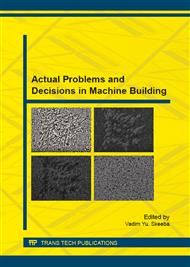p.69
p.75
p.82
p.88
p.95
p.102
p.111
p.117
p.123
Selection of Synthesis Corundum Grain in Grinding Flat Parts from Hardened Steel 30ChGSA by the Macrogeometry Criterion
Abstract:
The stochastic nature of grinding predetermines the necessity of attracting statistical methods to predict output parameters. In this research the form accuracy indices of flat workpieces EFEmax (the main parameter) and two additional indices EFEa and EFEq called the arithmetic average and the quadratic average, respectively are used (GOST 24642-81). In the conditions of violating normality and homoscedasticity of distributions the selection of the grain in the Norton high porous wheels (HPW) made of synthetic corundum 5SG (46, 60) K12VXP is made with an emphasis on a non-parametric method, wherein medians and quartile latitudes are used as one-dimensional frequency distributions. This paper states that grinding by the coarse-grained HPW 5SG46 in comparison with the small-grained 5SG60 made it possible to increase the form accuracy by the predicted medians within the same accuracy quality class: for EFEmax – TFE7; for EFEa and EFEq – TFE6. The precision of the form accuracy of the parts 30ChGSA increased most significantly: for EFEmax it increased by 5 times, for EFEa by 3.1 times, and for EFEq by 4.2 times. The fact that the heights of microasperity remained practically at the same level , μm; , μm was due to the features of the synthetic corundum grain structure. In this study the EFEmax parameter is used for selecting the wheel grain. The auxiliary parameters of form accuracy are used in calculating the correction indexes of basic models in the multivariate dispersion analysis because they have more information about the status of the part surface.
Info:
Periodical:
Pages:
95-101
Citation:
Online since:
August 2015
Authors:
Keywords:
Price:
Сopyright:
© 2015 Trans Tech Publications Ltd. All Rights Reserved
Share:
Citation:


